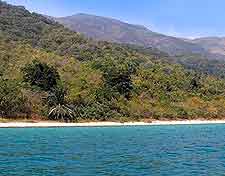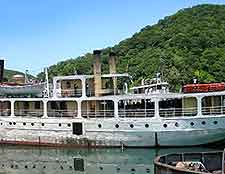Tanzania Lake Tanganyika
(Tanzania, TZ, East Africa)

A vast and lengthy lake, Tanganyika stretches for some 673 km / 418 miles, with a maximum width of approximately 72 km / 45 miles. Believed to be the second-biggest freshwater lake in existence anywhere on the planet, after only Siberia's Lake Baikal, Tanganyika is of epic proportions and Africa's deepest.
As well as edging Tanzania, the lake actually borders a further three different African countries - Burundi, the
Democratic Republic of the Congo and Zambia. The shoreline also comes with a number of bustling port towns, resorts and attractions, such as the town of Kigoma, the Gombe Stream National Park, the
Mahale Mountains National Park and the Monge Forest Nature Reserve.

General Information
Part of the Great Rift Valley and fed by both the Malagarasi River (east) and the Ruzizi River (north), the lake's main outflow is the Lukuga River. Many visitors enjoy excursions to Lake Tanganyika each year, coming to Kigoma via long-distance buses from Mwanza (around 20 hours) and other prominent destinations around Tanzania.
By train, the Central Line also connects Mwanza and Kigoma, as well as
Dar es Salaam and Tabora. Those heading from Zambia can catch a passenger ferry from Mpulungu.

Lake Tanganyika is famous for its wealth of cichlid fish, which number more than 275 different species. Many of these Tanganyikan cichlids are extremely colourful with distinctive stripes, being popular with aquarists all over the world. As a result, half-day and full-day scuba diving excursions are in demand with visiting tourists, who come to top dive spots such as Cape Mpimbwe. Diving anytime of the year is pleasant, with water temperatures averaging a warm 25°C / 77°F.
Commercial fishing in Lake Tanganyika has become big business in Tanzania, with literally tens of thousands involved in the surrounding fisheries and industry. Being so deep, the water at the very bottom is generally quite oxygen-deprived, meaning that there is little in the way of life there.
 A vast and lengthy lake, Tanganyika stretches for some 673 km / 418 miles, with a maximum width of approximately 72 km / 45 miles. Believed to be the second-biggest freshwater lake in existence anywhere on the planet, after only Siberia's Lake Baikal, Tanganyika is of epic proportions and Africa's deepest.
A vast and lengthy lake, Tanganyika stretches for some 673 km / 418 miles, with a maximum width of approximately 72 km / 45 miles. Believed to be the second-biggest freshwater lake in existence anywhere on the planet, after only Siberia's Lake Baikal, Tanganyika is of epic proportions and Africa's deepest.
 Lake Tanganyika is famous for its wealth of cichlid fish, which number more than 275 different species. Many of these Tanganyikan cichlids are extremely colourful with distinctive stripes, being popular with aquarists all over the world. As a result, half-day and full-day scuba diving excursions are in demand with visiting tourists, who come to top dive spots such as Cape Mpimbwe. Diving anytime of the year is pleasant, with water temperatures averaging a warm 25°C / 77°F.
Lake Tanganyika is famous for its wealth of cichlid fish, which number more than 275 different species. Many of these Tanganyikan cichlids are extremely colourful with distinctive stripes, being popular with aquarists all over the world. As a result, half-day and full-day scuba diving excursions are in demand with visiting tourists, who come to top dive spots such as Cape Mpimbwe. Diving anytime of the year is pleasant, with water temperatures averaging a warm 25°C / 77°F.